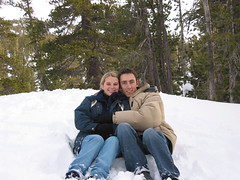The crowds of Chichen Itzá
We got up early again today, bought breakfast at a small shop (yogurt, a giant banana and what we thought were granola bars) and caught a cab to the ruins at Chichen Itzá, arriving just as they opened at 8:00. The first building we came to after walking down a short jungle path was the huge 'pyramid' named El Castillo by the Spanish and called the Pyramid of Kukulcán by the Mayans. It is a step pyramid 25 metres high and is the Mayan calendar formed in stone. The Mayans were big on maths and astronomy, and were actually the first civilization to use the concept of the number zero. El Castillo's 9 levels is divided into two by a huge staircase, making 18 separate terraces, representing the 18 20-day months in their year. The four stairways (one up each side) have 91 steps each, plus the top platform equals 365, the number of days in a year. One each side at the top of the pyramid are 52 flat panels, representing the 52 years in the Calendar Round (or 52 weeks in a year as I say). It's really fascinating to learn how this culture used maths and astronomy in building their cities. During the summer and winter equinoxes, the sun produces an illusion of a serpent ascending or descending the main staircase.
There are many different buildings and areas of these ruins, including many references to jaguars, skulls (most Mayans had some sort of human sacrifices, but the Mayans at Chichen Itzá became obsessed with them), eagles, warfare, and of course Chac-Mool the Rain God. The representation of Chac-Mool looks like a jigsaw puzzle of random geometric shapes meant to look vaguely like a square-headed, 2-dimensional 'person' with a huge 3-dimensional nose sticking out. Our theroy is that it is their version of an elephant, or what their ancestors described as an elephant. Nigel and I think the Mayans came from Asia somewhere at one time, and the images and stories of elephants (holding water in their trunks, swimming etc) were passed on and on and on until the image became mythical (there being no elephants in Mexico and Central America), and thus the idea of the Rain God looks kind of like an elephant. There are also remains of some sort of stadium (called a ball court)used for a game/ritual that archaeologists still don't understand fully.
We spent a surprising 4 hours at the site and were quite hot and sweaty by the end. As we neared the exit, we could hear some buzzing voice sounds. When we came up to the ticket booths, we saw that there were hundreds of people streaming into the site. Our timing could not have been more perfect, enjoying the site with relatively few people and leaving just as the hordes and tour groups arrived.
Back in Pisté, we packed up our gear, had some lunch, and then caught a bus west to Merida. It took longer than it should have, around 2.5 hours, and we were glad we had booked into a hostel. Mérida is a large city of about 700,000 and is the capital of the state of Yucatán. It was once the great Mayan city of T'ho and is now a charming, artsy town full of old Spanish colonial buildings and narrow streets. After getting organized at the Nómadas Hostel, we walked around a tiny bit, organised a rental car for tomorrow, and had some dinner. Back at the hostel we drank some beers out on the patio and listened to the free music they provide. Every night a señor comes to strum his guitar and sing some Mexican tunes. It was a nice, relaxing way to finish off the day.


2 Comments:
This comment has been removed by a blog administrator.
This comment has been removed by a blog administrator.
Post a Comment
<< Home